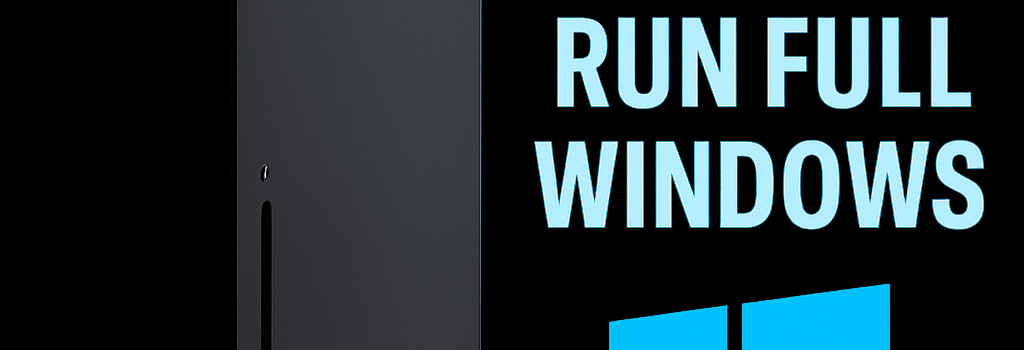Why Xbox Should Run Full Windows

Microsoft’s upcoming AMD-powered Xbox console is poised to blur the line between gaming PC and living-room box. By adopting a full Windows gaming stack—leveraging modern AMD Zen CPU cores, RDNA GPU architecture, and DirectStorage—Microsoft can deliver unrivaled performance, compatibility, and developer flexibility. Here’s an in-depth look at why the next Xbox should just run Windows already.
Shattering the Console-PC Divide
The traditional gap between console hardware and PC gaming has eroded over the past decade. Custom SoCs gave way to PC-style chiplets; closed ecosystems are giving way to open platforms. Windows achieves platform ubiquity on desktops, and an Xbox that boots a tuned Windows kernel would:
- Unlock Tens of Thousands of Games: Instantly support every Windows‐compatible title from Steam, Epic, GOG, and the Microsoft Store without porting overhead.
- Leverage Mature Middleware: Use ready-made tools like Unreal Engine and Unity with full DirectX 12 Ultimate feature sets (ray tracing, mesh shaders, variable rate shading).
- Streamline DevOps: Offer integrated CI/CD pipelines via Azure DevOps and GitHub Actions, reducing QA cycles for console releases.
WindowsBox: A Unified Gaming Environment
Building on initiatives like the ROG Xbox Ally and the Xbox Experience for Handhelds, Microsoft has already begun to re-skin Windows 11 into a console-friendly UI. A dedicated Xbox Experience for Consoles could live-boot Windows in “console mode,” disabling unnecessary services, optimizing memory, and prioritizing GPU scheduling.
“By making Windows the core of console gaming, we unlock cross-device play and seamless backward compatibility,”
— Phil Spencer, CEO, Microsoft Gaming (hypothetical commentary)
Hardware Architecture: Converging CPU and GPU
According to AMD’s recent disclosure at Computex 2025, custom Zen 5 cores can reach 4.1 GHz clocks on 5 nm process nodes while maintaining up to 20% IPC gains over Zen 4. Paired with an RDNA 3.5-derived GPU featuring 15+ TFLOPS of compute, the next Xbox could rival mid-range gaming PCs:
- CPU Subsystem: 8 Zen 5 cores with SMT, hardware virtualization (AMD-V), and integrated RDNA rendering engine.
- GPU Subsystem: 80+ compute units, hardware-accelerated ray tracing, mesh shading, and DisplayPort 2.1/HDMI 2.1 outputs.
- Memory & I/O: 24 GB GDDR7 at 24 Gbps, PCIe 5.0 lanes for NVMe expansion, DirectStorage with sub-20 ms load times.
Software Ecosystem and Developer Workflow
With a Windows-based console, developers gain direct access to:
- DirectX 12 Ultimate API: Single API across PC, console, and cloud, simplifying feature parity and reducing testing matrices.
- Windows Subsystem for Linux (WSL): Native support for cross-platform tools, containerized test rigs, and open-source renderers.
- Azure Integration: Cloud-based build servers, multiplayer backend via PlayFab, and real-time telemetry through Azure Monitor.
Expert voices, including former Xbox engineering leads, have indicated that a Windows base would slash certification time by up to 30%, as many QA and compliance checks are already baked into Windows 11.
Potential Challenges and Market Impact
Transitioning to Windows isn’t without hurdles:
- Revenue Model Shifts: Microsoft would need to rethink the 30% store fee on Win32/32-bit UWP titles—potentially adopting a tiered model similar to the new Microsoft Store policy (12%–17% fees).
- OEM Relationships: PC partners (Dell, HP, Lenovo) might resist Microsoft encroaching on living-room hardware territory.
- Platform Security: Ensuring a locked-down kernel in “console mode” to prevent piracy while preserving mod-friendly elements for enthusiasts.
Despite these challenges, a Windows-powered Xbox would redefine console sales dynamics, likely boosting hardware attach rates for Game Pass Ultimate and fostering a more vibrant developer community.
Market Dynamics and Strategic Implications
Hardware sales for the Xbox Series X|S have lagged behind the PS5 by roughly 20% globally, according to Q1 2025 NPD data. By reframing Xbox as a modular Windows device:
- Microsoft Strengthens Its Ecosystem: Tighter integration with PC, mobile (xCloud), and AR/VR (HoloLens) platforms.
- New Revenue Streams: Licensing the Xbox Experience OS to TV and set-top box manufacturers (e.g., Samsung, LG).
- Future-Proofing: Seamless upgrades through Windows Feature Updates and support for upcoming Windows 12 features like AI-accelerated drivers.
Conclusion: Embracing Windows for the Next Generation
By running full Windows in a console-optimized mode, Microsoft can finally unite its PC and console ambitions, delivering:
- A massive, unified game library
- Robust developer tools and reduced time-to-market
- Flexible hardware upgrade paths and cloud integration
In a gaming landscape defined by convergence—PC, console, handheld, and cloud—the next Xbox must capitalize on Windows’ ubiquity. It’s time for Microsoft to tear down the wall and let gamers have Windows in their Xbox.